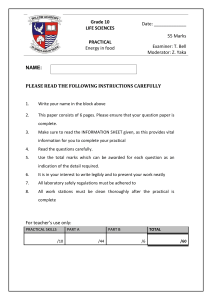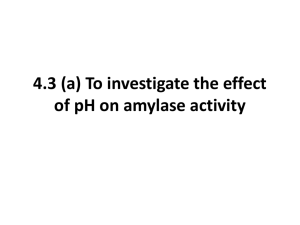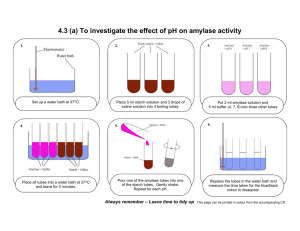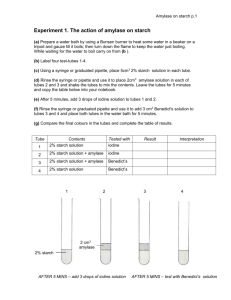Grade 10 Life Sciences Practical Exam: Energy & Microscopy
advertisement
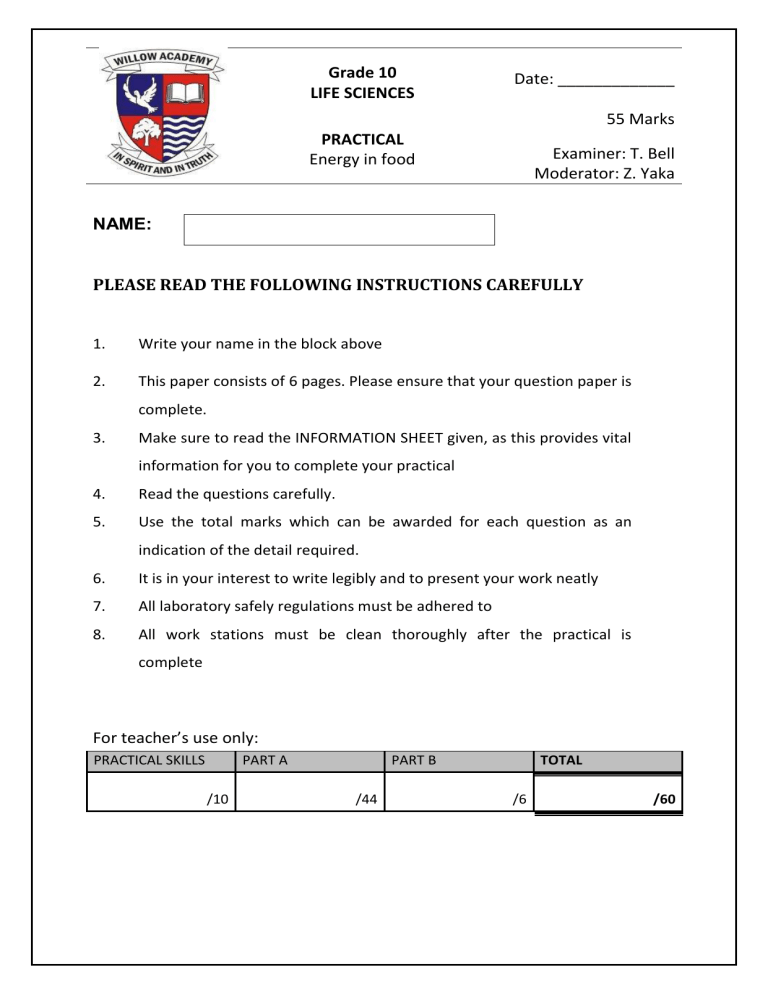
Grade 10 LIFE SCIENCES Date: _____________ 55 Marks PRACTICAL Energy in food Examiner: T. Bell Moderator: Z. Yaka NAME: PLEASE READ THE FOLLOWING INSTRUCTIONS CAREFULLY 1. Write your name in the block above 2. This paper consists of 6 pages. Please ensure that your question paper is complete. 3. Make sure to read the INFORMATION SHEET given, as this provides vital information for you to complete your practical 4. Read the questions carefully. 5. Use the total marks which can be awarded for each question as an indication of the detail required. 6. It is in your interest to write legibly and to present your work neatly 7. All laboratory safely regulations must be adhered to 8. All work stations must be clean thoroughly after the practical is complete For teacher’s use only: PRACTICAL SKILLS PART A /10 PART B /44 TOTAL /6 /60 You are going to investigate whether salivary amylase will break down starch Before the practical begins, ensure that you have the following, either in at your work bench or have access to them in the class: 3 test tubes Starch powder 50 ml distilled water Distilled water 2 wooden kebab sticks Measuring spoon Rinsing water Litmus paper (red and blue) Iodine Plastic lid 10 ml syringe Pipette dropper Saliva Paper towel Sheet of white paper Marker Wall clock Page 2 of 8 PART A – INVESTIGATION 1. Label your test tubes A, B, C, and D respectively 2. Measure 5 ml of starch powder and place in 50 ml of distilled water. Stir the contents until powder is dissolved 3. Using a clean syringe, add 10 ml of starch solution into test tubes A and B 4. Using a clean syringe add 10 ml of distilled water into test tube C 5. Add 5 drops of iodine solution into test tubes A, B, and C 6. Swirl the contents of each test tubes gently 7. Spit a few times into the empty lid 8. Using litmus paper, determine whether the salvia is acidic, basic or neutral. Write your answer in the space provided in the results table in Step 14 CALL YOUR INVIGILATOR TO CHECK YOUR PROGRESS BEFORE MOVING ON 9. Note any colour changes in test tubes A, B and C in the results table in Step 15 10. Spit once into test tube B and C. Stir the contents with a kebab stick. 11. Wait 10 minutes, swirling test tubes A and B occasionally 12. While waiting, proceed to Step 16 and come back to your experiment after 10 minutes is complete 13. After 10 minutes, record any colour changes in the table of results in Step 15 14. Record any colour changes in the results table below and provide a suitable heading for the table where indicated: Colour change Red litmus paper Blue litmus paper Alkaline or Acidic pH of saliva (3) Page 3 of 8 15. Heading: ___________________________________________________________ __________________________________________________________ Test tube Colour before iodine Colour after iodine (2) Colour change after saliva A B C (8) 16. What was the aim of this experiment? (2) ______________________________________________________________________ 17. Suggest an appropriate hypothesis for this experiment. (3) ______________________________________________________________________ ______________________________________________________________________ ______________________________________________________________________ 18. Write a conclusion based on the results that YOU collected. (2) ______________________________________________________________________ ______________________________________________________________________ 19. What is the dependent variable in the above experiment? (2) ______________________________________________________________________ 20. Give ONE control variable that was important for the fairness/success of this investigation. State clearly how you went about controlling it. (2) ______________________________________________________________________ ______________________________________________________________________ 21. If the test tubes were placed in a water bath at 60°C, what would you think would happen to the rate of reaction of salivary amylase? (2) Page 4 of 8 ______________________________________________________________________ ______________________________________________________________________ 22. The effect of temperature was investigated on the rate of human salivary amylase activity. The following results were obtained: Temperature (°C) 0 10 20 30 40 50 60 65 70 80 90 100 Rate of reaction 0 0 20 68 88 42 8 0 0 0 0 0 Plot a line graph of the above data on the grid provided on the next page Page 5 of 8 . (8) 23. Write the heading for your graph. (2) ______________________________________________________________________ 24. From your graph, what conclusions can you make about the effect of temperature on salivary amylase? (2) ______________________________________________________________________ ______________________________________________________________________ 25. What is the optimum temperature for salivary amylase? (2) ______________________________________________________________________ [44 marks] Page 6 of 8 PART B – Microscopy 1. Below is a photomicrograph of a microorganism called Paramecium sp. Calculate the true length of the microorganism along the dotted line, if the image was taken at 45 000X magnification. Give your answer in micrometres (ɥm). (4) 1 mm = 1000 ɥm ______________________________________________________________________ ______________________________________________________________________ ______________________________________________________________________ ______________________________________________________________________ 2. What is the difference between a cross section and a longitudinal section? (2) ______________________________________________________________________ ______________________________________________________________________ Page 7 of 8 3. Draw a biological drawing of the Paramecium sp in question 1. All biological rules apply. (6) [12 marks] Page 8 of 8
